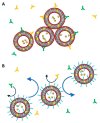Recent Advancements in Polymer/Liposome Assembly for Drug Delivery: From Surface Modifications to Hybrid Vesicles
- PMID: 33810273
- PMCID: PMC8037206
- DOI: 10.3390/polym13071027
Recent Advancements in Polymer/Liposome Assembly for Drug Delivery: From Surface Modifications to Hybrid Vesicles
Abstract
Liposomes are consolidated and attractive biomimetic nanocarriers widely used in the field of drug delivery. The structural versatility of liposomes has been exploited for the development of various carriers for the topical or systemic delivery of drugs and bioactive molecules, with the possibility of increasing their bioavailability and stability, and modulating and directing their release, while limiting the side effects at the same time. Nevertheless, first-generation vesicles suffer from some limitations including physical instability, short in vivo circulation lifetime, reduced payload, uncontrolled release properties, and low targeting abilities. Therefore, liposome preparation technology soon took advantage of the possibility of improving vesicle performance using both natural and synthetic polymers. Polymers can easily be synthesized in a controlled manner over a wide range of molecular weights and in a low dispersity range. Their properties are widely tunable and therefore allow the low chemical versatility typical of lipids to be overcome. Moreover, depending on their structure, polymers can be used to create a simple covering on the liposome surface or to intercalate in the phospholipid bilayer to give rise to real hybrid structures. This review illustrates the main strategies implemented in the field of polymer/liposome assembly for drug delivery, with a look at the most recent publications without neglecting basic concepts for a simple and complete understanding by the reader.
Keywords: drug release profile; encapsulation efficiency; hybrid vesicles; liposome surface modification; liposomes; mucopenetrating/mucoadhesive properties; physicochemical stability; polymers; stimuli-responsive properties; versatile targeting platform.
Conflict of interest statement
The authors declare no conflict of interest.
Figures












References
-
- Walde P. Preparation of Vesicles (Liposomes) In: Nalwa H.S., editor. Encyclopedia of Nanoscience and Nanotechnology. Vol. 8. American Scientific Publishers; Valencia, CA, USA: 2003. pp. 1–37.
-
- Gregoriadis G. Liposome Preparation and Related Techniques. CRC Press; Boca Raton, FL, USA: 2006.
-
- New R. Liposomes: A Practical Approach. IRL PRESS; New York, NY, USA: Oxford University Press; Oxford, UK: 1990.
Publication types
LinkOut - more resources
Full Text Sources
Other Literature Sources

